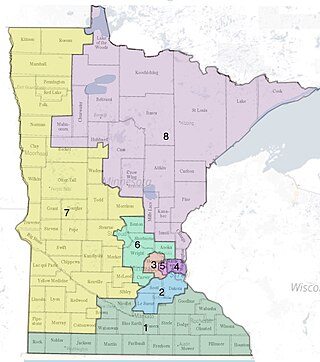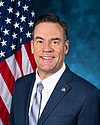
Ada County is located in the southwestern part of Idaho, United States. As of the 2020 census, the county had a population of 494,967, which by 2022 was estimated to have risen to 518,907. Ada County is by far the state's most populous county; it is home to 26.8% of the state's population. The county seat and largest city is Boise, which is also the state capital. Ada County is included in the Boise metropolitan area. The Ada County Highway District has jurisdiction over all the local county and city streets, except for private roads and state roads. In the interior Pacific Northwest east of the Cascade Range, Ada County ranks second in population, behind Spokane County, Washington.

These are tables of congressional delegations from the State of Texas to the United States Senate and United States House of Representatives.

Kansas is divided into 4 congressional districts, each represented by a member of the United States House of Representatives. The number of districts in Kansas remained unchanged after the 2010 census. Historically, the state has held as many as eight seats (1893–1933). The number of congressional seats decreased from five to four following the 1990 census. Between 1990 and 2000, the population of Kansas grew by 8.5% from 2,477,574 to 2,688,418, making it the 32nd most populated state; all four congressional seats were retained.

Minnesota is currently divided into eight congressional districts, each represented by a member of the United States House of Representatives. After the 2020 census, the number of Minnesota's seats remained unchanged.

As of the 2010 census, there are five United States congressional districts in Oklahoma. It was one of the states that was able to keep the same number of congressional districts from the previous census. Following the 2018 elections, a Democratic challenger ousted a Republican incumbent, changing the congressional delegation to a 4-1 Republican majority. The Republicans regained the seat in 2020 when Stephanie Bice defeated Horn.

Illinois is divided into 17 congressional districts, each represented by a member of the United States House of Representatives. The majority of Illinois' districts are located in the Chicago area.

California is the most populous U.S. state; as a result, it has the most representation in the United States House of Representatives, with 52 Representatives. Each Representative represents one congressional district.

Wisconsin is currently divided into 8 congressional districts, each represented by a member of the United States House of Representatives. After the 2020 census, the number of Wisconsin's seats remained unchanged.

After the 2000 census, the Commonwealth of Pennsylvania was divided into 19 congressional districts, decreasing from 21 due to reapportionment.

Florida is divided into 28 congressional districts, each represented by a member of the United States House of Representatives. After the 2020 census, the number of Florida's seats was increased from 27 to 28, due to the state's increase in population, and subsequent reapportionment in 2022.

Arizona is divided into nine congressional districts, each represented by a member of the United States House of Representatives. Since the 2008 elections, Democrats and Republicans have alternated holding a majority of seats in the delegation in six of the last eight elections.

Utah is divided into 4 congressional districts, each represented by a member of the United States House of Representatives. After the 2010 census, Utah gained one House seat, and a new map was approved by the state legislature and signed into law by Governor Gary Herbert.

Michigan is divided into 13 congressional districts, each represented by a member of the United States House of Representatives.

Iowa is divided into four congressional districts, each represented by a member of the United States House of Representatives. The state's congressional map is roughly divided by quadrants in the northeast, northwest, southeast, and southwest sections of Iowa.

The 2008 congressional elections in Idaho were held on November 4, 2008 to determine who would represent the state of Idaho in the United States House of Representatives, coinciding with the presidential and senatorial elections. Representatives are elected for two-year terms; those elected were to serve in the 111th Congress from January 3, 2009 until January 3, 2011.

Idaho's 2nd congressional district is one of two congressional districts in the U.S. state of Idaho, in the eastern portion of the state. Beginning with the 2012 election, the district expanded westward and now includes most of Boise, the state capital and largest city. The district is currently represented by Mike Simpson, a Republican of Idaho Falls. A former dentist in Blackfoot, he was first elected in 1998; the seat opened when his predecessor Mike Crapo successfully ran for the U.S. Senate.

Idaho's 1st congressional district is one of two congressional districts in the U.S. state of Idaho. It comprises the western portion of the state. The 1st district is currently represented by Russ Fulcher, a Republican from Meridian, who was first elected in 2018, and re-elected in 2020 and 2022.

The U.S. state of West Virginia currently has two congressional districts, each represented by a member of the United States House of Representatives.

The 2012 United States House of Representatives elections in Idaho were held on Tuesday, November 6, 2012 and elected two U.S. representatives, one from each of the state's two congressional districts. The elections coincided with those of other federal and state offices, including a quadrennial presidential election. Candidate filing took place between February 27 and March 9, 2012. Primary elections were held on May 15, 2012.

Maryland is divided into eight congressional districts, each represented by a member of the United States House of Representatives. After the 2020 census, the number of Maryland's seats remained unchanged, giving evidence of stable population growth relative to the United States at large.


































